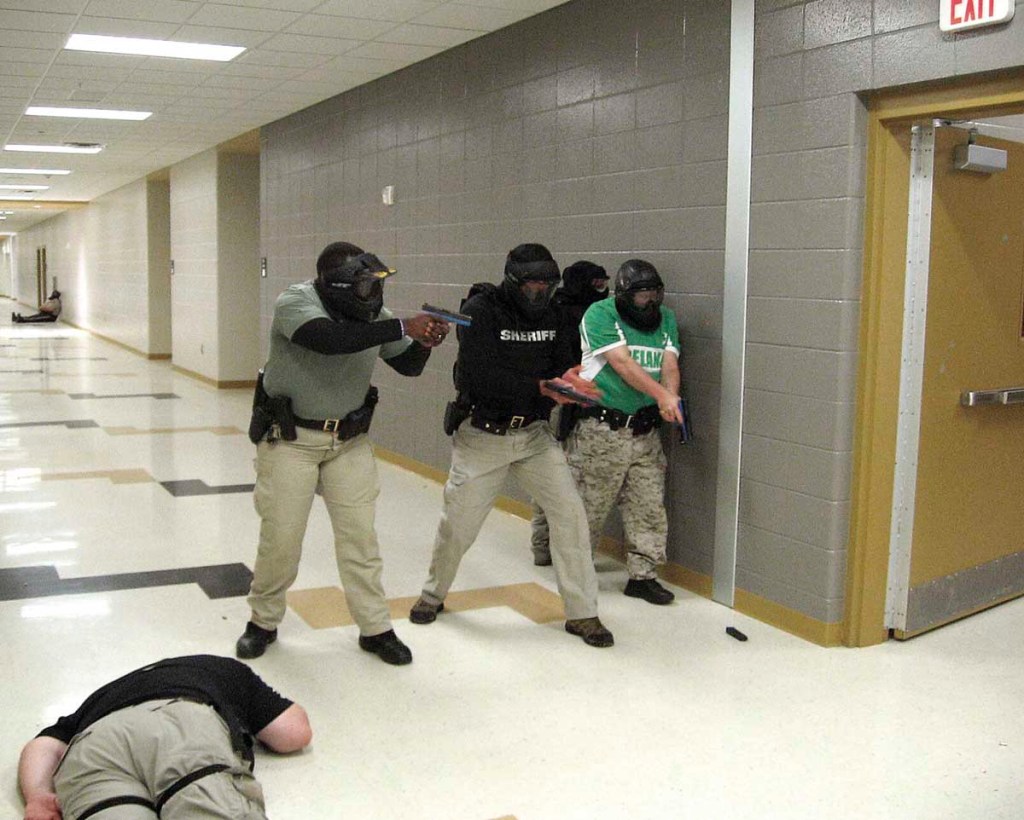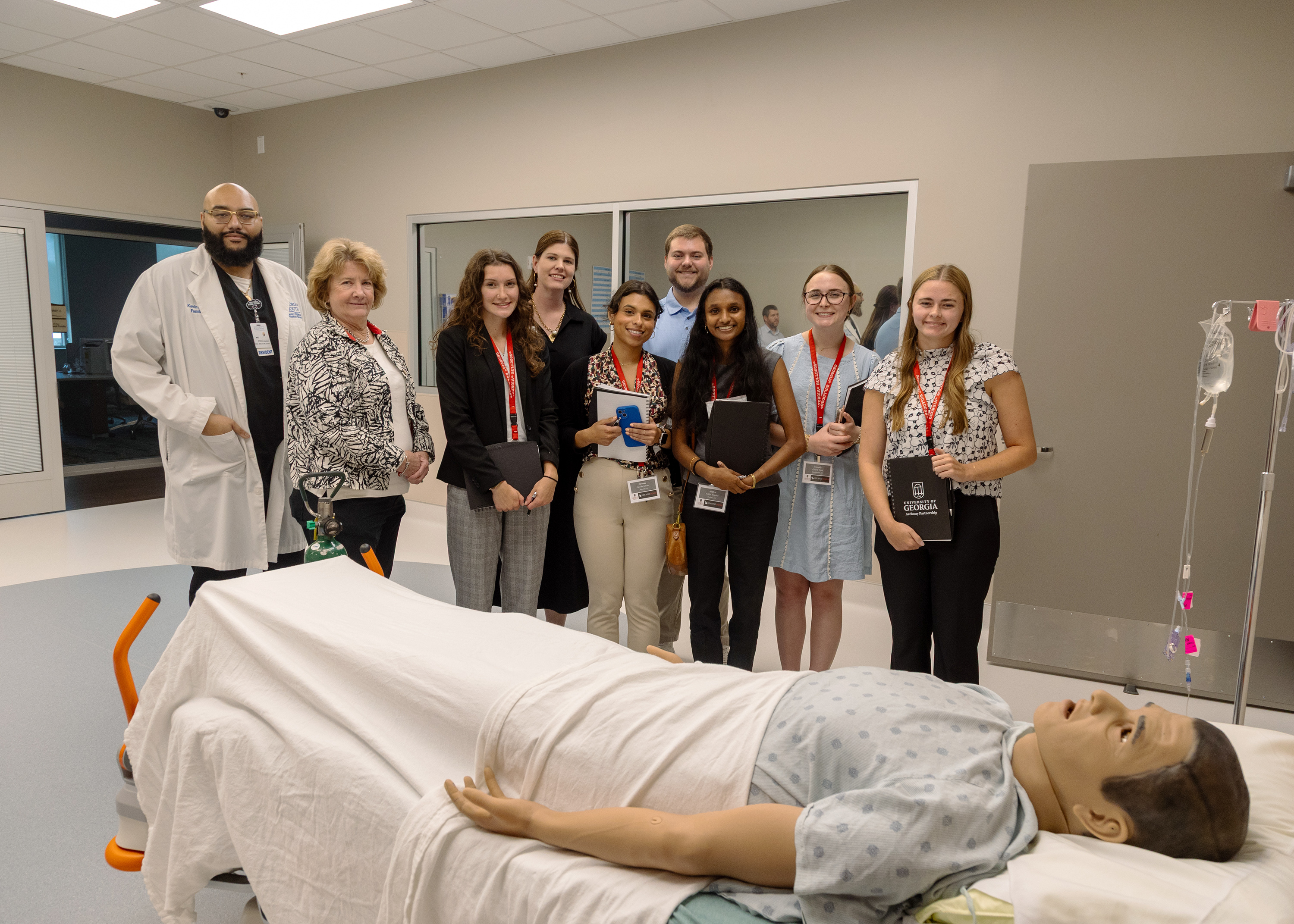School reps weigh in on safety, proposals
Published 9:30 am Friday, June 24, 2022

- Shooting "victims" -- played by law enforcement personell -- lie in the hall as four officers search for the bad guy in an active-shooter scenario staged at Colquitt County High School in March 2018. Those officers are Colquitt County Sheriff's Office Sgt. Chris Thomas, left, the Moultrie Police Department's Sgt. Eric Hill and patrolman James White, and sheriff's deputy J.C. Mustelier.
ATLANTA — In light of the mass school shooting in Uvalde, Texas, in late May, school safety and security have been in the forefront of conversations related to gun reform.
The Texas shooting took the lives of 19 elementary school students and two teachers. In 2022, there have been at least 27 school shootings this year and 119 since 2018, according to Education Week.
The Uvalde tragedy has brought attention to mishaps and safety breaches that likely aided in the killer’s spree, prompting school districts to continue their assessments of safety measures and trainings.
For example, there were conflicting reports on whether a school resource officer — sworn law enforcement officers responsible for safety and crime prevention in schools — was on campus when the shooter arrived at Robb Elementary School in Uvalde.
It was initially reported that the school’s SRO made contact with the shooter before entering the school; however, it was later determined the SRO was not on campus at the time.
National Association of School Resource Officers — which provides training to school-based law enforcement officers — recommends that every school have at least one carefully selected, specially trained school resource officer — though many schools do not have them.
A 2018 report by the National Center for Education Statistics noted that 42% of public schools claimed they had at least one SRO present at least one day a week during the 2015-16 school year.
Limestone County School District in Alabama is one of a few districts that has an SRO at every school during school hours.
“Personally, I feel like there needs to be that SRO there with a weapon. Having that officer there with that weapon is important to us,” said Rusty Bates, director of transportation, safety and athletics. “Our sheriff has made that commitment to make sure they’re highly trained.”
Among LCSD’s 16 schools, about $750,000 is budgeted for each school to have a full-time SRO, Bates said; the cost is split with the school district county commission/sheriff’s department. The district started with SROs in all high schools and moved to put them in all schools after the Sandy Hook Elementary School shooting where 20 children and six adults were killed in December 2012.
Among the schools in Tift County School District in South Georgia, four security personnel make their rounds at each building to perform safety walk-throughs with checklists. Schools in Georgia’s Colquitt County School District are nearly fully staffed with SROs — with 10 SROs among its 13 schools, with full-time SROs in middle and high schools, said Angela Hobby, the district’s communications officer.
“We partner with the city and the issues that the city has trying to find enough officers; they’re in the same boat that a lot of agencies around the country are in (that) trying to find highly qualified officers is difficult,” said Adam Hathaway, superintendent for Tift County Schools.
School SROs, local law enforcement, along with school staff and students conduct a mass shooter training of some sort at least once per year. Per Georgia law, school safety plans must be developed in coordination with local law enforcement and the local juvenile court system.
After the school safety plans have been developed, they must be submitted to the local emergency management agency and the local law enforcement agency for approval.
Hathaway mentioned other security upgrades to facilities and practices during the last several years, including upgraded points of entry in all school buildings and the implementation of secure vestibules — there, people enter through one single entrance and are cleared and given a badge before being allowed entry into the school.
A fairly new technology implemented in the district, the Centegix alert system, allows every faculty member with a badge to institute a lockdown wherever they are in a school.
“If they see something out of the ordinary they can report it. If they see someone walking up to the school with a gun, (they are) able to push that button and lock the school down immediately,” Hathaway said. “The faster we’re able to react and put time and space between us and the shooter, the better. If we lock a door, that slows them down.”
Bates explained how the instant school lockdown systems used in LCSD helped implement a quick lockdown when police were in pursuit of a suspect.
A SafeDefend panic box located in classrooms and throughout schools requires a staff’s thumb print to activate, and the Rave Panic Button phone app that allows school staff to do the same.
“(The suspect) had cut through the campus and once he cut through the campus, he was seen and the alarms were activated and we went on full lockdown,” Bates said. “We’ve invested almost $2 million into the system, but there’s no measurable number for a deterrent.”
While many districts already have a position dedicated to overseeing safety functions and programs, Georgia’s Colquitt County School District on June 20 announced it is hiring a new part-time position — director of school safety — to constantly refine districtwide school safety plans, which is one of several tasks currently overseen by the assistant superintendent of student services.
“We’re hoping that this person will really take all of the things we’re doing and make sure that we’re actually using them for what they’re intended for,” Hobby said. “… Do checks at our campus sites, walk about to look and see if there may be an area of concern … issues with doors … and ensure that we have a more constant evaluation of our school safety procedures to make sure we’re not overlooking anything. They’ll also coordinate all of our drills from this point on.”
Colquitt County schools also installed new cameras throughout the schools, including inside all classrooms this year.
“It’s used for instruction but local authorities have access to it should there be an incident where we have to have an emergency response,” Hobby told The Moultrie Observer.
The district also implemented an Anonymous Alert System, which, based on what is reported, an alert is shared to the appropriate department. For example, if there is an alert submitted regarding self-harm or bullying, the alert will be transferred to school counselors. Law enforcement can also receive alerts.
“Using the system can be one of the most impactful ways to get information both to the school and legal authorities,” Superintendent Ben Wiggins told The Observer.
Many districts including Limestone and Tift use a similar system to help prevent school tragedies.
“We want to encourage people in our community that if they hear something, say something, even if they think that it may not be true or real. Let’s get out in front of it before it becomes an act of terror,” Hathaway said.
In the Uvalde school shooting, the door entrance to the school was unlocked, though police are investigating why the door did not lock when it had been closed by a staff member just before the shooter entered. It is unclear whether the classroom door where the shooter barricaded inside was unlocked.
“The No. 1 thing that has typically been apparent is when they get to a locked door, they move on because they don’t want to waste time,” Hathaway said. “If we do not have teachers and students that will not lock the door and not keep them propped open, it doesn’t matter. The most important piece to school safety is the people that are in that building.”
There have been proposals across the country to allow teachers to carry guns in schools; a nearly 10-year-old Georgia law empowers local school boards to arm teachers.
In a NPR/PBS NewsHour/Marist National Poll of more than 1,000 adults, 51% said they would vote against a congressional candidate who wants to allow teachers to carry guns. Democrats (82%) are more than four times as likely as Republicans (19%) to oppose such a measure.
Alabama Department of Education Superintendent Eric Mackey said while he does not support proposals to arm teachers, the state has firearm certification program for teachers, instituted in 2018.
Teachers who complete the program can store a gun at an undisclosed, secure location within the school.
“They’re allowed to handle a gun, they can’t carry with them. The gun has to be locked up in a secure place in the school that’s not publicly known.”
No record is maintained of which teachers or schools may have a gun permitted under this program, he said.
Mackey cautioned against a proposal to allow teachers to carry weapons. He referenced various scenarios where the proposal could back fire: a teacher leaving students unattended to go shoot an intruder or a teacher could be accidentally shot by police who could mistake the teacher for the intruder.
“As far as a teacher carrying a weapon on their side, I have strong reservations about that,” Mackey said. “Because if a shooter comes into a school, God forbid, we need the teacher following the protocol, making sure their children are safe, following the ‘Run, hide, fight’ training.”
Bates suggested if teachers are allowed to carry a gun, physical and skill training, along with with mental health training must be mandatory.





